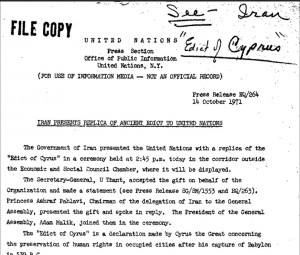 In 1971 the Princess of Iran Ashraf Pahlavi, sister of Shah Reza Pahlevi, presented the United Nations Secretary General U Thant with a replica of Cyrus Cylinder. This archeologic artefact stems from the 6th century BC and was excavated in 1879 by Hormuzd Rassam, an Iranian-British archeologist. On the clay cylinder a declaration is written in Akkadian cuneiform script, guaranteeing equal rights to every subordinate of the Achaemenid king Cyrus the Great, independent of their nation or religion. In the late 1960s the Cylinder gained new prominence when the last Shah of Iran called it “the world’s first charter of human rights”. The cylinder was a key symbol of the Shah’s political ideology and is still regarded by some commentators as a charter of human rights, despite the disagreement of some historians and scholars. He wrote that “the history of our empire began with the famous declaration of Cyrus, which, for its advocacy of humane principles, justice and liberty, must be considered one of the most remarkable documents in the history of mankind.”
In 1971 the Princess of Iran Ashraf Pahlavi, sister of Shah Reza Pahlevi, presented the United Nations Secretary General U Thant with a replica of Cyrus Cylinder. This archeologic artefact stems from the 6th century BC and was excavated in 1879 by Hormuzd Rassam, an Iranian-British archeologist. On the clay cylinder a declaration is written in Akkadian cuneiform script, guaranteeing equal rights to every subordinate of the Achaemenid king Cyrus the Great, independent of their nation or religion. In the late 1960s the Cylinder gained new prominence when the last Shah of Iran called it “the world’s first charter of human rights”. The cylinder was a key symbol of the Shah’s political ideology and is still regarded by some commentators as a charter of human rights, despite the disagreement of some historians and scholars. He wrote that “the history of our empire began with the famous declaration of Cyrus, which, for its advocacy of humane principles, justice and liberty, must be considered one of the most remarkable documents in the history of mankind.”
On top of the UN protocol about the ceremony are some handwritten remarks, which show that even in the surpreme international organisation some people had difficulties in not mixing historical characters and places of the mideastern hemisphere. Instead of linking Iran to the “Edict of Cyrus”, they “newly invented” an “Edict of Cyprus”. It would be interesting to find out if a copy of this protocol was ever forwarded to the Shahs palace in Teheran, maybe with a post-it saying “For your information” !! This typo remained unnoticed for more than 40 years, although the protocol must have been available in the web since several years.
The entire UN protocol can be found here.
I wonder if it was a delibrate mistake? or Careless mistake?
Dear Marijam, as an possible reason, but not an excuse, for this confusion about Cyrus (the great) and Cyprus (the island) among some UN coworkers one should consider the political situation in the middle-east at the late 60s/early 70s. Iran was a rather prosperous country, showing economic and social stability and was internationally respected. Within the “commonworth of the blockfree states” it was one of the countries with the highest living standard. Consequently, Iran under Shah Reza Pahlevi was never a big issue for the UN. Cyprus, in contrast, had UN troops based on their territory to prevent the tensions between different political and ethnic groups mounting to a violent conflict. After the formally declared independence from Britain in 1960 caused only more violence between the greek and the turkish population, mounting to more than 1000 victims of riots and massakers. Hence, Cyprus in the 60s was for the UN a major concern, perhaps like the Israel-Palestine conflict today.
The Cyprus conflict and their management had probably occupied more than half of all UN activities, whereas Iran was an island of stability.
Therefore, I dont think that the spelling mistake on this UN protocol was done intentionally. I think it simply reflects where in the world in these years the conflicts and the concerns of the UN were located. For Cyprus, the last 40 years went on a slow but steady path towards economic and political stability and cooperation between the two ethnic groups. Hence, Cyprus went very far down on the UN agenda. Iran probably replaced Cyprus as the top issue for the UN. I would therefore not be surprised if on a modern UN document about “Cyprus” one finds it mispelled as “Cyrus”.
در توضیح بیشتر سخنان جناب الف باید عرض کنم که این کپیه در سال 1971 توسط اشرف پهلوی خواهر شاه وقت ایران به سازمان ملل اهدا شد.
رسید دریافت آن هم در این آدرس موجود است.. http://persian-cat.de/?attachment_id=2271